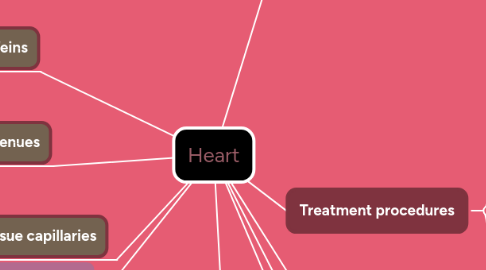Heart
by Sara Alsh

1. Pathology
1.1. Atherosclerosis; hardening of arteries with a collection of cholesterol-like plaque.
1.2. Aneurysm; local widening of an artery caused by weakness in the arterial wall or breakdown of the will form atherosclerosis
1.3. Angina; chest pain caused by decreased blood flow to heart muscle.
1.4. Arrhythmia; abnormal heartbeat.
1.5. Congestive heart failure; inability of the heart to pump its required amount of blood.
1.6. Hypertension; high blood pressure.
1.7. Myocardial infarction; heart attac. An infarct is an area of dead (necrotic)tissue.
2. Veins
3. Venues
4. Tissue capillaries
5. Arteries
6. Treatment procedures
6.1. Cardio version; brief discharges of electricity passing across the chest to stop a cardiac arrhythmia.
6.2. Coronary artery bypass graffiti (CABG); vessels taken from the patient ‘t legs are connected to coronary arteries to make detours around blockage.
6.3. Endarterectomy:surgical removal of the innermost lining of an artery to remove fatty deposits and clots.
6.4. Heart transplantation; a donor heart is transferred to a recipient.
7. Laboratory tests & diagnostics procedures
7.1. Angiography: recording; (via x-ray images) blood vessels after the injection of contrast into the bloodstream.
7.2. Cardiac catheterization.(C.C); introduction a catheter into coronary blood vessels to measure pressure and flow patterns of blood.
7.3. Cardiac enzyme tests; measurements of enzymes released into the bloodstream after a heart attack.
7.4. Electrocardiography; recording electricity flowing through the heart.
7.5. Lipid tests:measurements of cholesterol and triglyceride levels in the blood.
7.6. Magnetic resonance imaging (MPR)producing an image by beaming magnetic waves at the heart.
7.7. Stress tests;an electrocardiogram plus blood pressure and heart rate measurements shows the heart’s response to physical exertion (treadmill test).
8. Blood vessels
9. Arteries
10. Aorta


